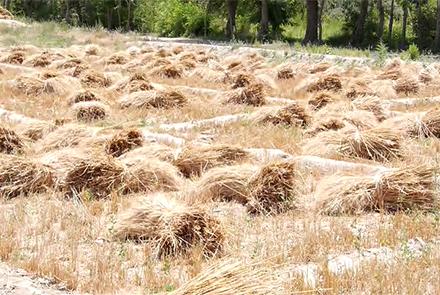Wheat yields in Takhar have decreased by 25 percent against last year as water levels drop in irrigated agricultural areas in the north-eastern province.
Lack of rainfalls and irregular rains are main reasons behind the decrease in wheat produce, head of provincial office of agriculture, irrigation and livestock, Salam Saee, said.
He said every farmer produced 3,500 kilograms of wheat from each hectare of land last year but this amount, he said, has reduced to 2,600 kilograms of wheat from each hectare of land.
Some farmers have stopped wheat cultivation, he said, adding that other crops such as melon and watermelon have also been affected by lack of water and rainfalls.
“Unfortunately, this year lack of water and steep and irregular winds affected the stems of cultivated wheat and this reduced the wheat crops. The wheat produce has reduced by 25 percent this year compared with the last year,” Saee said.
Meanwhile, he said wheat product is normal in non-irrigated agricultural areas.
“The rainfall however was useful for rain-fed fields. For instance, in rain-fed agricultural areas where pea, sesame, melon, watermelon and other plants were cultivated. The result was good because the lands were softened due to the rainfalls,” he said.
Takhar farmers meanwhile said lack of rainfalls has reduced their products in recent years. They said rainfalls and winds were irregular this year.
“We have nothing this year. We could not met our cost. Government should help us,” said Mohammad Dayim, a farmer in Takhar.
“The irregular rains and steep winds damaged our fields this year. Our products are much less this time,” said Abdul Jami, a farmer in Takhar.
Takhar is not the only province in Afghanistan which has been affected by drought this year. Statistics by Afghanistan National Disaster Management Authority (ANDMA) in April showed that 21 provinces are faced with drought due to a 45 percent drop in rainfalls this year.
The authority said it will provide forage for the provinces within the next two months and that it has plans to help the residents as well.
“The main problem is (lack of) forage because incomes of people are depended on farming and livestock,” Mohammad Qasim Haidari, deputy of ANDMA’s policy, told TOLOnews in April.
The Ministry of Finance said last month 250 million AFs has been allocated in an amended budget and that the ministry is discussing the matter with the international community.
According to ANDMA, at least $500 million is required to overcome consequences of drought in the country.
On April 24, UNICEF said in a statement that extremely dry winter has affected 22 provinces across Afghanistan and now threatens to negatively impact the lives of one million people, with an additional two million who could feel its effects over the coming months.
Food insecurity and reduced access to safe water are beginning to take their toll in the 10 worst affected provinces, where 20 to 30 percent of water sources are reportedly dry, the statement read.

